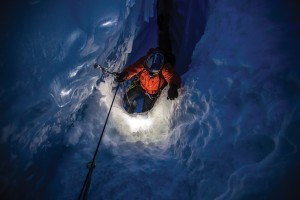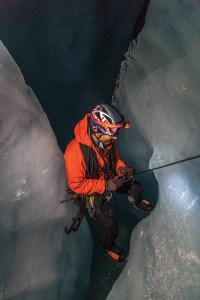
Ice climbing legend Will Gadd is at it again.
Earlier this month he descended nearly 50 metres into the Athabasca Glacier with a team of scientists to see firsthand how climate change is affecting the glacier from within.
“We were trying to learn a little bit more about how glacial melt water moves through glaciers,” said Gadd, who spent his high school years in Jasper and made headlines in 2015 when he became the first person to ice climb Niagara Falls.
To get inside the glacier the team had to rappel down a moulin, a frozen stream that disappears into a large hole in the ice.
“The interesting thing was the moulin was packed with snow so the first thing we had to do was this kind of tunneling exercise for about 10 metres vertically, but what was weird was that there was this warm air coming up,” said Gadd.
“It was a difficult situation to dig that much snow to get where we wanted to go, but we got through it by following the warm air, which was odd,” said Gadd.
“Why would there be warm air coming out of a glacier?”
The mystery seemed only to deepen as the group made their way deeper into the glacier.
“The first thing we discovered as we popped out into this amazing passage, which was just like a beautiful sandstone canyon made of ice, was the temperature gradient. It was plus-one underneath the glacier,” said Gadd. “It was really weird.”
After travelling a couple more hundred metres laterally and nearly 50 metres vertically the group was stunned by what they found next.
“There was liquid water in there, in the middle of winter at -30,” said Gadd, explaining the temperature reached a balmy three degrees Celsius.
“How is this possible? We were all kind of at a kind of loss.”
According to Gadd, the water wasn’t moving, but there were large pools of water similar to what someone might find in a sandstone canyon.

He said there are a lot of different theories about why this might be.
“If a glacier is at -20 a one degree change in global temperatures isn’t probably a big deal to that glacier, but for a temperate glacier, which is what the Athabasca Glacier is, it may only be relatively close to freezing at minus one or minus two, so a swing of one of two degrees in global temperatures may impact the glacier,” explained Gadd.
Besides discovering liquid water, the team also discovered life under the surface of the glacier.
“If you’ve ever been up skiing, you sometimes see what looks like mosquitos on the surface of the snow, but they’re not, and we found a bunch of those down there flying around,” said Gadd.
That wasn’t the only thing that surprised the group. The next thing they found was a form of algae.
“These biofilms have apparently not been seen below the surface of a glacier before either, so we need to go back and get samples of these biofilms and work with Parks to get permission to do that.”
For Gadd, the three-day expedition from Dec. 13-15 has completely changed his perspective on glaciers.
“You’re driving along the Parkway at -30 and you look out and you think ‘wow, there’s really not much going on in there,’ but obviously there’s a tremendous amount going on underneath the surface of these glaciers even at -30,” said Gadd.
During the expedition part of the group also tried to get inside the glacier by entering through the toe of the glacier, but discovered the ice caves that had been there in previous years had completely collapsed.
He blamed the collapse partly on climate change, which has caused the Athabasca Glacier—one of six toes of the expansive Columbia Icefield—to lose more than five metres of ice every year.
“It’s retreated massively since when I was a kid,” said Gadd. “I think everybody sees the glacier recession and that’s a big deal, but one of the things that I learned on this trip that surprised me, is that it’s actually the vertical loss that’s greater than the horizontal loss.”
“It’s not as obvious, but if you look along the sides of the Athabasca Glacier you can see it’s lost probably 100 metres or more of ice and if you think about that it’s like going from a very, very thick block of ice down to a relatively thin skating rink,” said Gadd.
The three-day expedition included experts from the National Science and Technology Museum in Ottawa, Martin Sharp, a professor with the Department of Earth and Atmospheric Sciences at the University of Alberta and a Parks Canada interpreter.
Gadd said he intends to return to the Athabasca Glacier to do further research in the future.
Paul Clarke
[email protected]
